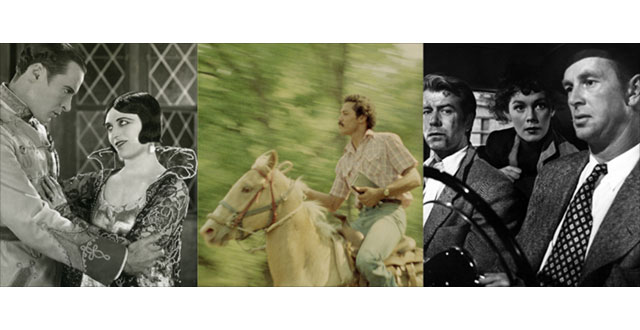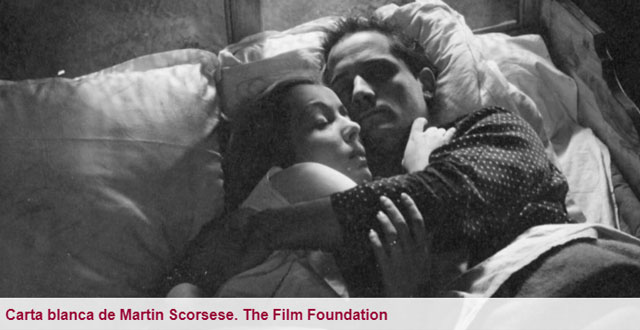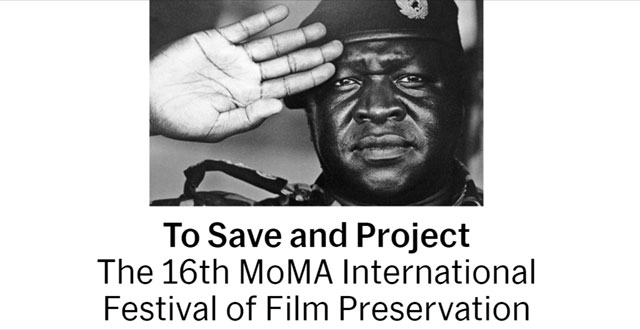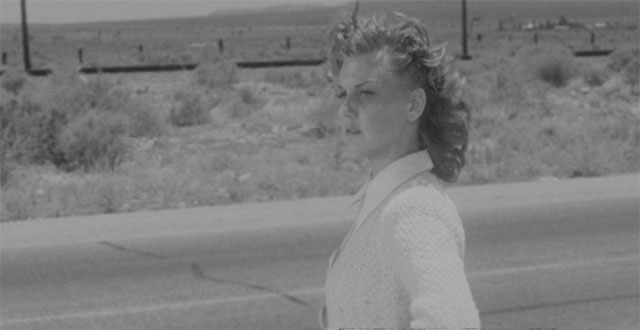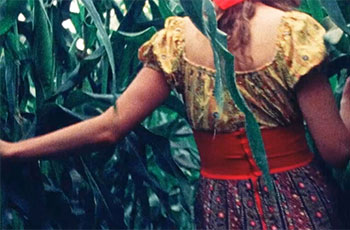News
The Museum of Modern Art’s “To Save and Project” Series Gives Classics New Life on the Big Screen
Rebecca Pahle
Friday, January 4 sees the kick-off of the 16th annual edition of To Save and Project, the Museum of Modern Art’s annual series of newly restored features and shorts. If the term “film preservation” brings to mind silent films creeping up on their centennials (no shade there—silents are great), those perusing this year’s lineup may be in for a surprise. The 50 features and shorts being screened this year span almost a century, from the teens (Changing Hues: Color Innovations in British Silent Cinema and the two-part Great Victorian Moving Picture Show) to the 1980s.
That latter category includes two films—Buddies (1985) and Cane River (1982)—that exemplify one of the missions espoused by Josh Siegel, curator of MoMA’s Department of Film. “There are a great many independent films, particularly by traditionally marginalized groups—whether LGBTQ or African-American or women filmmakers who never got their due—that are still very much in danger of disappearing.”
Written and directed by Arthur J. Bressan Jr., the raw and exceptionally moving Buddies is one of the first films to tackle the AIDS crisis. (Bressan himslef died two years after the film’s release of AIDS-related complications.) Cane River, meanwhile, is the sole film of Horace Jenkins, who wrote as well as directed this love story about two African-American young adults, one from the lighter-skinned, more affluent side of their Louisiana community, the other from the darker-skinned, poorer side. Joyous and vibrant, the film found an early champion in Richard Pryor but failed to secure much by way of a theatrical release. The new 4K restoration of Cane River has its New York premiere on Friday, January 18, with an additional screening on the 31st. Put simply, the film is a revelation, which makes it all the more sad that Jenkins died shortly after completing it.
Among the films directed or co-directed by women this year are Ida Lupino’s Never Fear (1950), Márta Mészáros’ The Two of Them (1977), Yvonne Rainer’s Journeys from Berlin/1971 (1980), Chantal Akerman’s Histoires d’Amérique: Food, Family and Philosophy (1989), Safi Faye’s Fad’jal (1979), and Raymond Phelan and Doris Wishman’s Nude on the Moon (1961), a bit of exploitation camp where a couple of astronauts stumble upon a nudist colony… on the moon.
The older films you’d expect to see at a preservation-themed film festival are still represented. There’s the early Ernst Lubitsch film Forbidden Paradise (1924), starring a delightfully risqué Pola Negri as a Queen who seduces her lady-in-waiting’s fiance. There’s a new English translation of F.W. Murnau’s Faust (1926) and, skipping forward a decade, Alexander Korda’s The Private Life of Henry VIII (1933), Fernando de Fuentes’ The Phantom of the Monastery (1934), and that same year’s Finishing School. A Ginger Rogers comedy, Finishing School is the only feature directed by screenwriter Wanda Tuchock, one of only two women (along with the prolific Dorothy Arzner) to direct within the Hollywood studio system in the 30s.
While some of the films in To Save and Project’s 2019 lineup are available through home video, Siegel stresses that “even though you may know these films, you may not be able to see them in quite this way.” “Quite this way” meaning restored, in a theater, absolutely gorgeous. Siegel cites the surreal 1961 thriller Night Tide, starring Dennis Hopper as a sailor who falls in love with a woman who just might be a killer mermaid. “Night Tide may be somewhat well-known, but I don’t think it has ever looked as good as it does now, because of the digital work that’s been done on the original camera negative and fine grain master.” Also high on the list in terms of gorgeous visuals is the Soviet drama Fragment of an Empire (1929), with cinematography by Gleb Bushtuyev and Yevgeni Shneider. The new digital restoration, by the San Francisco Silent Film Festival and EYE Filmmuseum in partnership with Gosfilmofond of Russia, gives us imagery that’s nothing short of striking, its play of high contrast against urban architecture calling to mind the decades-later The Third Man.
André De Toth’s Crime Wave (1954), starring Sterling Hayden, represents both the importance of screening restorations theatrically and one of the main difficulties of doing so. “It’s not an unknown film,” Siegel explains. “It’s actually a beloved noir film. But it became clear from talking to various people who’ve done noir series that it is exceedingly hard to get ahold of this film” in 35mm instead of a “crappy 16mm print.” MoMA, because of their close relationship with Warner Bros., was able to get the 35mm—and their sole screening of the film, on Saturday, January 19th, may be “your last chance to see a brand new print struck from the original camera negative.”
No matter how well-known, no matter how old or young, films—particularly the high-quality versions that MoMA screens—are in danger of disappearing if they’re not taken care of and if the studios that own prints don’t make them accessible. Even MoMA itself, Siegel admits, has films in their archives that, before he started To Save and Project sixteen years ago, were shelved away instead of shared with the public. “A film like Forbidden Paradise, or last year’s Rosita—we’ve had the best materials on these Lubitsch films for decades, and only now, partly because of digital preservation techniques, have we been able to make them more widely accessible here in this festival, but also at festivals abroad and with any luck theatrical runs.”
Argues Siegel, “The situation in some ways as is as perilous now as it was in the 1950s, because people have the illusion that because [a film] was made digitally it is infinitely reproducible and storable, and that if you simply put something on a hard drive, putting it in the freezer, it will still be intact in even 20 years. With the change of technologies that have rapidly accelerated over the last several decades, I think that we’re looking at potentially another disaster situation where a great many independent films are lost to us forever. And that, coupled with the vagaries of distribution platforms and the uncertainty of where things are going, makes it doubly the case.”
Still, Siegel cites the increase of independent cinemas across the United States as cause for optimism. “I do hope that we can bring some iteration of this festival, or just MoMA preservation more generally, to these other cinemas across the country. I think it’s part of our mandate, our mission at this museum.”
La Filmoteca Española exhibe en enero obras maestras restauradas de Scorsese y Kenji Mizoguchi en pantalla grande
La Filmoteca Española dedicará parte de su programación del mes de enero a títulos emblemáticos de la historia del cine que han pasado recientemente por un proceso de restauración y que se verán en el cine Doré en dos ciclos que han denominado 'Carta blanca de Martin Scorsese. The Film Foundation' y 'Kenji Mizoguchi. Los últimos años'.
La Filmoteca Española dedicará parte de su programación del mes de enero a títulos emblemáticos de la historia del cine que han pasado recientemente por un proceso de restauración y que se verán en el cine Doré en dos ciclos que han denominado 'Carta blanca de Martin Scorsese. The Film Foundation' y 'Kenji Mizoguchi. Los últimos años'.
El ciclo 'Carta blanca de Martin Scorsese' contará con 18 películas elegidas por el propio Scorsese, que son parte de un listado de más de 800 filmes restaurados desde 1990 gracias al apoyo de su fundación, The Film Foundation, y servirá como cierre a la programación que la Filmoteca Española ha dedicado durante octubre, noviembre y diciembre de 2018 al cineasta italoamericano.
Algunos de los títulos que se verán en esta primera etapa de la programación serán 'L'Atalante' de Jean Vigo (1934), 'Rebelde sin causa' de Elia Kazan (1955) y 'Lost Lost Lost' de Jonas Mekas (1976), entre otros.
Por otro lado, la Filmoteca Española también presentará 'Kenji Mizoguchi. Los últimos años', en colaboración con Capricci Cine, que contará con ocho películas de la última etapa del cineasta japonés que han sido recientemente restaurados o remasterizados.
Asimismo, el cine Doré proyectará en enero dos trabajos de restauración llevados a cabo por la Filmoteca Española: 'Campanadas a medianoche' de Orson Welles, restaurada bajo la dirección del historiador Luciano Berriatúa y presentada en el Festival de Venecia en 2009; y 'Noventa minutos' de Antonio del Amo, restaurada en noviembre de 2018.
TO SAVE AND PROJECT, MoMA’S 16TH ANNUAL INTERNATIONAL FESTIVAL OF FILM PRESERVATION, PRESENTS NEWLY RESTORED MASTERWORKS AND CINEMATIC REDISCOVERIES FROM AROUND THE WORLD
Barbet Schroeder Opens the Festival with a Full Retrospective of His Documentaries, and Filmmaker Guests Also Include Peggy Ahwesh, George Griffin, Yvonne Rainer, and Arturo Ripstein
Festival Features Classics by Chantal Akerman, Ha Gil-jong, Ernst Lubitsch, Ida Lupino, Márta Mészáros, F. W. Murnau, Doris Wishman, and Many Others
To Save and Project: The 16th MoMA International Festival of Film Preservation January 4–31, 2019 The Roy and Niuta Titus Theaters
NEW YORK, December 6, 2018—The Museum of Modern Art announces the 16th annual edition of To Save and Project, a festival dedicated to celebrating newly preserved and restored films from archives, studios, distributors, foundations, and independent filmmakers around the world. Running from January 4 to 31, 2019, this year’s festival includes more than 50 newly preserved features and shorts from Asia, Europe, Africa, Latin America, and the United States—virtually all of them North American or New York premieres—by filmmakers as diverse as Fernando de Fuentes, André de Toth, Safi Faye, Ha Gil-jong, F. W. Murnau, and Doris Wishman. Many of these films are receiving their first American screening since their original release; others will be shown in meticulously restored versions that recapture the long-lost sound and image quality of their initial release; and some will be publicly screened for the first time ever in New York. To Save and Project is organized by Joshua Siegel, Curator, Department of Film, The Museum of Modern Art.
To Save and Project opens with a tribute to Barbet Schroeder through all of his documentaries. Schroeder, who is also celebrated for fiction films like Tricheurs, Reversal of Fortune, Barfly, and Single White Female, will present his self-described “trilogy of evil”: General Idi Amin Dada: A Self Portrait (1974), Terror’s Advocate (2007), and the New York premiere theatrical run, from January 4 to 10, of The Venerable W. (2017). He will also introduce new digital preservations of Koko: A Talking Gorilla (1978), The Charles Bukowski Tapes (1985), and three rarely screened anthropological shorts made in 1971 in Papua, New Guinea during the shooting of his fiction film The Valley (Obscured by Clouds).
Other highlights include special guest appearances by Peggy Ahwesh, Wolf-Eckart Bühler, George Griffin, Barbara Hammer, Yvonne Rainer, and Arturo Ripstein; “The Great Victorian Moving Picture Show”—two illustrated lectures of astonishing large-format 68mm Mutoscope and Biograph shorts from the late 19th century—as well as an illustrated lecture on color innovations in British silent cinema; Michael Anderson’s spy thr 2 35mm print struck from the original camera negative, together with two merciless (auto-)portraits of the film’s leading actor, Sterling Hayden, made at the end of his life; and the North American premiere of MoMA’s own restoration of Ernst Lubitsch’s Forbidden Paradise (1924), in association with The Film Foundation. The festival concludes with the world premiere theatrical run, from January 25 to 31, of MoMA’s new restoration of Ida Lupino’s melodrama Never Fear (The Young Lovers) (1950).
Other highlights include:
- Spotlight on Female Filmmakers. Female filmmakers are represented in depth through narrative and documentary features by Chantal Akerman, Safi Faye, Ida Lupino, Márta Mészáros, Wanda Tuchock, and Doris Wishman, as well as avant-garde work by Peggy Ahwesh, Barbara Hammer, Jenni Olson, and Yvonne Rainer. Included are new restorations of Belgian filmmaker Chantal Akerman’s Histoires d’Amérique: Food, Family and Philosophy (1989), the Senegalese-French filmmaker Safi Faye’s Fad’jal (1979), the Hungarian Márta Mészáros’ Ők Ketten (The Two of Them) (1979), and MoMA’s new restoration of Yvonne Rainer’s Journeys from Berlin/1971, which is presented in memory of the film’s “star” (scholar Annette Michelson, who died this past September), with the American artist and choreographer Rainer present to introduce. Also included are Doris Wishman’s recently preserved Nude on the Moon (1961); Peggy Ahwesh’s The Color of Love (1994); Wanda Tuchock and George Nicholls’s Finishing School (1934), a late pre-Code melodrama starring Ginger Rogers and Frances Dee; and a weeklong run (January 24 to 31) of MoMA’s new restoration of Ida Lupino’s Never Fear (The Young Lovers) (1950).
- Rediscovering African American and LGBTQ Independent Cinema. To Save and Project presents underappreciated independent African American and LGBTQ filmmakers, including the New York premiere of writer-director Horace Jenkins’ Cane River (1982), a film championed by Richard Pryor. The festival highlights the brief but astonishing film career of Edward Owens with three experimental films from the late 1960s: Private Imaginings and Narrative Facts, Remembrance: A Portrait Study, and Tomorrow’s Promise. Owens was marginalized for decades as a gay African American artist.
For a special Martin Luther King Day celebration on January 21, the annual “Orphans at MoMA” program presents rarities of African American and LGBTQ cinema. The screening opens with Something Good—Negro Kiss (Selig Polyscope Co., 1898), a burlesque of Thomas Edison's John C. Rice-May Irwin Kiss (1896), starring the black performers Saint Suttle and Gertie Brown, newly preserved by the University of Southern California Hugh M. Hefner Moving Image Archive. Orphans at MoMA also includes Cab Calloway’s home movies, early television kinescopes, and vernacular films from the Washington, DC, community, all newly preserved by the National Museum of African American History and Culture; a rare 1966 TV newsfilm of Martin Luther King Jr. on voting, from the University of South Carolina; and Nikolai Ursin’s remarkably candid 1967 portrait of an African American trans woman, Behind Every Good Man . . . , a 16mm preservation through the Outfest UCLA Legacy Project. Orphans at MoMA also showcases the American filmmaker Barbara Hammer through some of her earliest Super 8 works in their original small-gauge format: the abstract Contribution to Light (1968), her psychodrama Death of a Marriage (1968), and Aldebaran Sees (1969). These films heralded one of Queer Cinema’s most radical and questioning artists. 3 50 years of LGBTQ independent cinema is further represented with New Queer Cinema pioneer Curtis Harrington’s thriller Night Tide (1961), starring Dennis Hopper, in a meticulous new digital restoration from the original camera negative and a finegrain master, carried out by Cinema Preservation Alliance for byNWR. Also included are Frameline’s new digital preservations of Jenni Olson’s short Blue Diary (1998) and Arthur J. Bressan Jr.’s Buddies (1985).
- Classics and Rediscoveries of Mexico and South Korea. Mexican writer-director Arturo Ripstein will present a new restoration of his overlooked melodrama La mujer del porto (The Woman of the Port) (1991), a tawdry tale of the docks adapted from a short story by Guy de Maupassant and told from three perspectives. Ripstein also presents the Filmoteca UNAM’s preservation of the original Woman of the Port (1934), a masterwork of expressionistic Mexican popular cinema by Arcady Boytler, who wrote, directed, and starred in films in his native Russia, associating with Sergei Eisenstein, before moving to Mexico. Classic Mexican cinema is also represented with the world premiere of UCLA Film & Television Archive and The Film Foundation’s newly restored El fantasma del convento (The Phantom of the Monastery) (1934), Fernando de Fuentes’ pioneering work of Mexican gothic horror. Though widely admired as one of the great films of 1970s Korean cinema, Ha Giljong’s Babodeuli haengjin (The March of Fools) (1975) was violently cut by censors before its theatrical release. Thanks to the Korean Film Archive, Ha’s dark comedy can be seen in its original Director’s Cut, painting an even more claustrophobic picture of Korea’s lost generation during the dictatorial regime of Park Chung-hee.
- Silent Cinema. In addition to MoMA’s restoration of Ernst Lubitsch’s Forbidden Paradise, this year’s To Save and Project includes two other significant restoration premieres from the silent era: the Munich Filmmuseum’s restoration of F. W. Murnau’s Faust (1926), presented for the first time with celebrated novelist Gerhart Hauptmann’s original intertitles; and the brand-new restoration of Fridrikh Ermler’s intense psychological drama Fragment of an Empire (1929), a masterpiece of Soviet cinema, in a collaborative effort of EYE Filmmuseum, Gosfilmofund of Russia, and the San Francisco Silent Film Festival.
On January 12 and 13, To Save and Project presents three illustrated lectures on astonishing innovations in silent cinema. In the first of two companion programs titled “The Great Victorian Moving Picture Show,” BFI curator Bryony Dixon introduces some of Britain's earliest and most spectacular films, documenting current events and personalities of the late Victorian era with astonishing clarity on large-format 68mm film. In the second program, archivist and historian Paul Spehr and MoMA archivist James Layton present an illustrated lecture on early film pioneer W. K. L. Dickson, with an emphasis on the remarkable cinematic advancements he made with the American Mutoscope and Biograph Company at the turn of the 20th century. This program features 68mm shorts from The Museum of Modern Art's Biograph collection. On January 13, Bryony Dixon presents “Changing Hues: Color Innovations in British Silent Cinema,” a beguiling journey through early color experiments and innovations in British silent cinema, featuring a wide gamut of screen color techniques from hand coloring to “natural” color processes like Kinemacolor and Biocolour. 4
- A Spectrum of Projection Formats, from Small Gauge to Cutting-Edge Digital. This year’s festival encompasses a wide range of projection formats, from small gauge to the latest technological advancements in digital restoration. On January 21, Barbara Hammer presents a rare screening of some of her earliest Super 8 films in their original format. On January 12, “The Great Victorian Moving Picture Show” features astonishing large-format 68mm Biograph films, which can be justly described as the IMAX of turn-of-the century cinema. Throughout To Save and Project are 4K digital restorations that have successfully rescued severely damaged or decomposing negatives and prints through cutting-edge technologies, recapturing the long-lost image and sound quality of their initial release.
See accompanying screening schedule for full program details and guest appearance dates.
Special thanks to Cindi Rowell, Olivia Priedite, and Julia Mettenleiter.
SPONSORSHIP: Support for the exhibition is provided by the Annual Film Fund. Leadership support for the Annual Film Fund is provided by the Kate W. Cassidy Foundation and Steven Tisch, with major contributions from Jo Carole and Ronald S. Lauder, Association of Independent Commercial Producers (AICP), Yuval Brisker Charitable Foundation, The Brown Foundation, Inc., of Houston, Marlene Hess and James D. Zirin, Karen and Gary Winnick, and The Junior Associates of The Museum of Modern Art. Electronic subtitling provided by Sub-Ti Ltd.
Press Contacts:
Sara Beth Walsh: sarabeth_walsh@moma.org
Stephanie Davidson: stephanie@frankpublicity.com
For downloadable high-resolution images, register at moma.org/press.
Public Information: The Museum of Modern Art, 11 West 53 Street, New York, NY 10019, (212) 708-9400, moma.org. Hours: Saturday–Thursday, 10:30 a.m.–5:30 p.m., Friday, 10:30 a.m.–8:00 p.m. Museum admission: $25 adults; $18 seniors, 65 years and over with I.D.; $14 full-time students with current ID; free, members and children 16 and under (includes admittance to Museum galleries and film programs). Free admission during Uniqlo Free Friday Nights: Fridays, 4:00–8:00 p.m. No service charge for tickets ordered on moma.org. Tickets purchased online can be printed out and presented at the Museum without waiting in line (includes admittance to Museum galleries and film programs). Film and after-hours program admission: $12
A New Restoration Brings Detour Back to the Big Screen
The Current
Made on a shoestring budget, Edgar G. Ulmer’s 1945 Detour is a landmark of film noir, a hardboiled thriller that represents the genre at its seediest and most fatalistic. But despite amassing critical acclaim and a significant cult following over the decades, the film has long been available only in substandard public-domain prints that fall short of conveying the pulp poetry of its images. This week, New York audiences will finally get a chance to see Detour in pristine condition when it opens for a theatrical run at Film Forum, which will be followed by engagements across the country. The first major restoration of the movie is the result of the hard work of the Academy Film Archive and The Film Foundation, who collaborated with the Cinémathèque Royale de Belgique, the Museum of Modern Art, and the Cinémathèque Française, with funding provided by the George Lucas Family Foundation, to bring Detour to stunning new life.
The journey to this newly restored version began sixteen years ago, when Ulmer’s daughter, Arianne Ulmer Cipes, brought her collection of film elements and video masters to the Academy Film Archive and asked if the team there could help with giving her father’s masterpiece the treatment it deserved. The director of the Academy Film Archive, Michael Pogorzelski, and film preservationist Heather Linville ended up supervising the complicated process of tracking down existing prints and ultimately piecing together the best elements. There was a 16 mm print that had gone through much wear-and-tear from being in circulation, and was used for reference in the restoration. There was also a 35 mm duplicate negative in the collection of the Museum of Modern Art, but it too was a problematic source: it contained a number of jump cuts, the result of many missing frames that were lost from the 35 mm release print from which it was made. “Heather spent ten years (on and off) searching the world for 35 mm elements that were comparable to or of higher quality than the MoMA element,” Pogorzelski says.
Finally, last year, the Archive had a breakthrough when it contacted the Cinémathèque Royale de Belgique in Brussels, which holds a 35 mm nitrate print of Detour in its collection. “This element had never been considered as a possible preservation source because it contained both Flemish and French subtitles burned into the frame,” Pogorzelski explains. “We asked to have a scan made thinking that perhaps we might get lucky and find some shots that didn’t contain subtitles that could fill in the frames that were missing from the MoMA element. Instead of a few frames here and there, we got one of the best surprises of our careers: the print had been struck from the original camera negative of Detour, and the image quality was better than anything we had seen in ten years of searching.”
But even with this exciting discovery, there were still challenges ahead, including the question of how to remove the subtitles from the Cinémathèque’s 4K scans without affecting the quality of the image. Roundabout Entertainment in Burbank, California, developed and tested two methods to accomplish this. First, frames from the subtitled Brussels print were composited with frames from the MoMA negative. But because the MoMA print was missing frames, and because significant camera movement resulted in unsatisfactory composites, the second approach was to meticulously paint out the subtitles by hand. And after this work was done, a single shot that didn’t exist in either element was sourced from a safety 35 mm print housed at the Cinémathèque Française.
As you can see from the below gallery, which features three stills from various print sources provided by the Archive, the team had their work cut out for them. But the final results, reflected in the last framegrab in the gallery, are “the best that Detour has looked or sounded for generations,” says Pogorzelski. “The restoration reveals that, despite the severe restrictions of time and budget, Edgar G. Ulmer and his collaborators were able to craft one of the best and purest film noirs of all time.”

1/4

2/4

3/4

4/4
A more detailed account of the restoration will be available on our Detour Blu-ray and DVD edition, coming out next year. In the meantime, if you’re in New York, head to Film Forum’s website to check out showtimes for the theatrical run!
